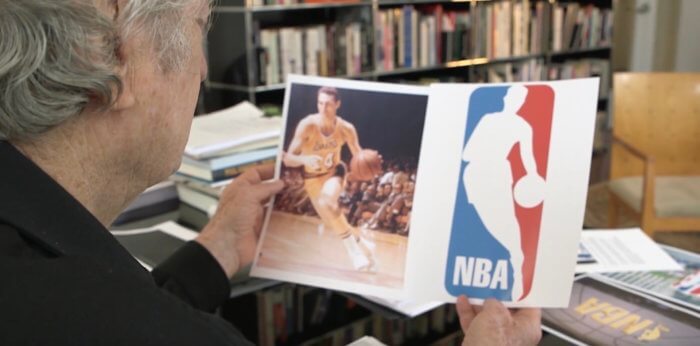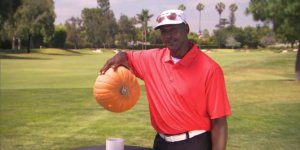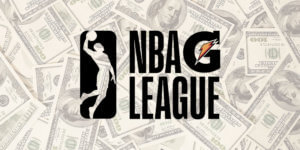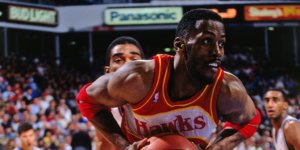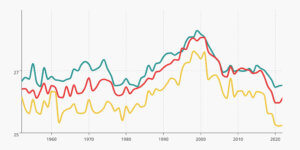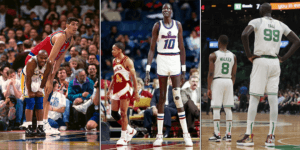When you think of iconic NBA images, you might see Jordan flying through the air or Kobe crossing up an opponent. You might think of Curry’s three pointers or Magic’s layup.
A different image that may come to mind is the NBA logo. The red, white, and blue silhouette is one of the most iconic and well-known logos out there. But what makes it so memorable, and also so irreplaceable? Let’s find out!
The History of the NBA Logo
After merging the NBL (National Basketball League), ABL (American Basketball League), and BAA (Basketball Association of America), the NBA became the single professional basketball league in the United States. Today, the league consists of 30 teams; 29 from the US and 1 from Canada.
Much like the NBA has changed and adapted over the years, so has its logo. The first three league logos were simple, based on the image of a basketball rather than a player.
1950-1953
The NBA’s first logo, created in 1950, featured a white circle representing a basketball. It read “National Basketball Association” with the current year printed along the top.Especially with the red and white coloring and the positioning of the writing, the logo was often mistaken for that of a baseball.
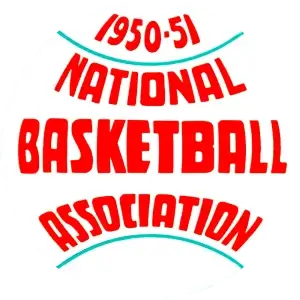
1953-1962
The original logo was replaced in 1953 with the image of a basketball. It was more like the actual color of a basketball and was positioned at an angle, reading “NBA” across the ball in white lettering.
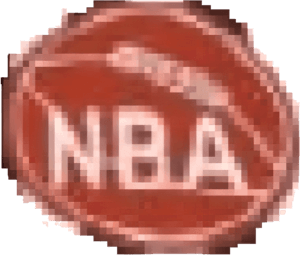
1962-1969
The third logo, used from 1962 to 1969, reverted back to a white basketball. However, it had four black seams showing in order to appear more like the basketball than a baseball. The “NBA” lettering was in black as well, positioned diagonally across the ball.
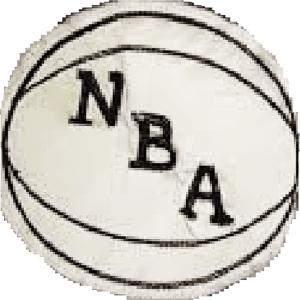
1969-2017
The NBA logo we know today was created in 1969. This logo took a different approach in terms of imaging, color, and shape.
Instead of a basketball it features the silhouette of a man dribbling a basketball. The colors changed to red, white, and blue to reflect a more patriotic emblem. Like the two logos before it, the “NBA” letters remained, but moved to the bottom corner.

2017-Today
In 2017 the NBA logo experienced its first refresh in 48 years. The changes however were minor:
- The font is a little narrower and more dynamic
- The colors also feature richer hues of red and blue to make the logo stand out more on screens or on merchandise
In general, the style of the iconic logo was kept the same, and most people barely notice a difference between the two logos.
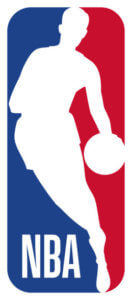
Who Created the NBA Logo?
The current logo was designed in 1969 by Alan Siegel, founder of the branding company Siegel+Gale. At the time he was hired, the NBA faced pressure from the rival ABA (American Basketball Association). The NBA was also having some difficulty with their reputation. The leagues were competing for the attention and loyalty of the fans and the country.
The NBA, and commissioner Walter Kennedy, knew they needed a successful rebrand in order to come out of the rivalry victorious. The MLB had adopted a new logo the previous year (including red, white, and blue colors and a the silhouette of a player) which was very well-received among fans and viewers, and was also created by Siegel.
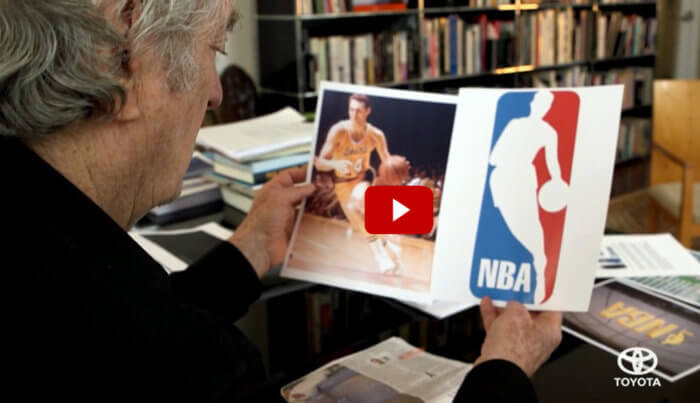
Before designing the NBA logo, Siegel searched photos in Sport Magazine for inspiration. He knew Kennedy wanted a silhouette, but he wanted to find the perfect image. He eventually found a photo of one of Los Angeles Lakers’ iconic players – Jerry West!
The photo checked all of the boxes for what he was looking for. It was a vertical photograph, it captured the grace and fluid movement he wanted the logo to embody, and it was a player he liked. Throughout the process of creating the logo, and for years after, Siegel never disclosed who the silhouette was a photograph of.
Who Is on the NBA Logo?
Jerry West is not just a great basketball player, he faced adversity many times over, but never quit and never let it break his spirit.
Born in 1938, West is the fifth of six siblings that grew up in West Virginia. Abused by his father as a child, he used to sleep with a gun under his pillow, afraid that he may have to use it in self-defense. In 1951, Jerry went from aggressive to shy and introspective after the passing of his brother, who died in the Korean War. Both of these would go on to play a huge part in his character as well as his work ethic.
West was a standout player at both East Bank High School and West Virginia University. In his four years at WVU, he earned numerous accolades, including All-American honors and Southern Conference MVP. He finished his collegiate career with 2,309 points and 1,240 rebound. After college, West co-captained the US Men’s Basketball Team that won the gold medal at the 1960 Summer Olympics.
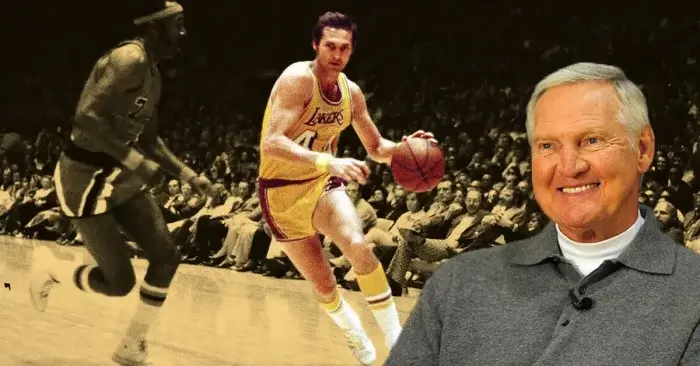
During the 1960 NBA draft, West was drafted 2nd overall by the Minneapolis Lakers before they relocated to Los Angeles. He spent his entire career with the Lakers, spanning from 1960 to 1974.
Nicknamed “Mr. Clutch,” “Mr. Outside,” and “The Logo,” West was known for many things throughout his career, mainly his talent, his character, and his work ethic. Part of the Lakers and Boston Celtics Rivalry of the 60’s and 70’s, West and the Lakers dropped six NBA Finals championships to the Celtics and one to the New York Knicks before West finally got his championship. In 1972, the Lakers won the NBA Finals against the Knicks, and West was named an NBA All-Star, All-NBA, All-Defense first team, and All-StarGame MVP.
His list of career achievements is long, including having his number retired by the Lakers and the Mountaineers. He was an NBA scoring champion and a leader in assists in two separate seasons. He was named 10-time All-NBA first team and 14-time NBA All-Star. At the end of his career, West had scored more points than any other Laker in franchise history.
West never embraced his role as “Mr. Logo.” Despite the fact that there was never a record of Jerry’s image being what inspired the logo, he says he always knew it was based on him. He was flattered that he was chosen to represent the logo, but was also embarassed. One thing teammates and coaches could tell anyone about Jerry is that he was shy and hated attention. Being “The Logo” brought just that – extra attention.
Any pride he had eventually became disdain, as that became his legacy. Not his achievements and not his hard work, but just being reduced to a single image. He hated that he was known as the logo. He eventually got past his anger and resentment, but still believes that the logo should be changed. His recommendations include Michael Jordan’s jump man, LeBron James’ breakaway dunk, or Kareem Abdul Jabbar’s sky hook shot.
Where are Siegel and West now?
Since creating the NBA logo, Alan Siegel has gone on to have a hugely successful career. After leading Siegel+Gale, he created Siegelvision in 2011. Siegelvision focuses on solving branding and communication issues for companies and organizations. He is a renowned author, presenter, and photography collector.
He serves on various boards and committees, including the Legal Aid Society, Hamptons International Film Festival, John Jay College of Criminal Justice, and the American Theater Wing (on which he is a Tony Award voter). Fun fact about Siegel: he can go 9 for 10 from the 3-point line!
After retiring from the NBA, Jerry West went on to coach int he NBA. He coached the Lakers for three seasons, leading them to a record of 145-101. After coaching, he became an NBA Executive, working for the Lakers, Grizzlies, Warriors, and (currently) Clippers. As an executive he has been part of eight NBA Championship teams, and he has been named NBA Executive of the Year twice.
Adding yet another award to his name, West received the Presidential Medal of Freedom in 2019.
Plans for a Logo Redesign?
In January of 2020, the NBA lost one of the greatest of all time, Kobe Bryant, in a tragic helicopter crash. Many people thought an appropriate way for the NBA to honor Kobe’s legacy would be to change the logo. The idea floated around social media and was supported by his wife, Vanessa, but never gained any traction.
Jerry West would support an NBA logo change to MJ…
— SportsNation (@SportsNation) October 22, 2015
How about any of these, Jerry? pic.twitter.com/wcNzgMGyM2
Kyrie Irving posted an image to Instagram to revisit the idea, stating, “BLACK KINGS BUILT THE LEAGUE.” For many, this was an extremely legitimate argument for changing the logo. It seemed to fit: West would get his wish of being replaced by a new logo representative, Kobe would be honored, and the NBA would more accurately represent the base of their players.
Bryant will never be the logo for two reasons. The first is his involvement in a sexual assault case. Although he was never found guilty because the victim refused to testify, this was enough for the NBA to decide that Bryant, albeit only a silhouette, would never be the face of the NBA logo.
The second reason applies to all replacement logo ideas, not only to Bryant. The emblem has been associated with the NBA for over half a century. Changing the logo would have legal and commercial ramifications, considering the NBA league products bring in more than a billion dollars in revenue every year.
Many people have noted that there’s a should and a will element to changing the NBA logo. Should the NBA honor West’s wishes and change the logo to someone other than him. Yes. Should the league recognize other players, specifically in order to elevate the league’s players of other races and nationalities? Yes. Will the league change it’s logo? As of right now, the answer to that is simple. No.

